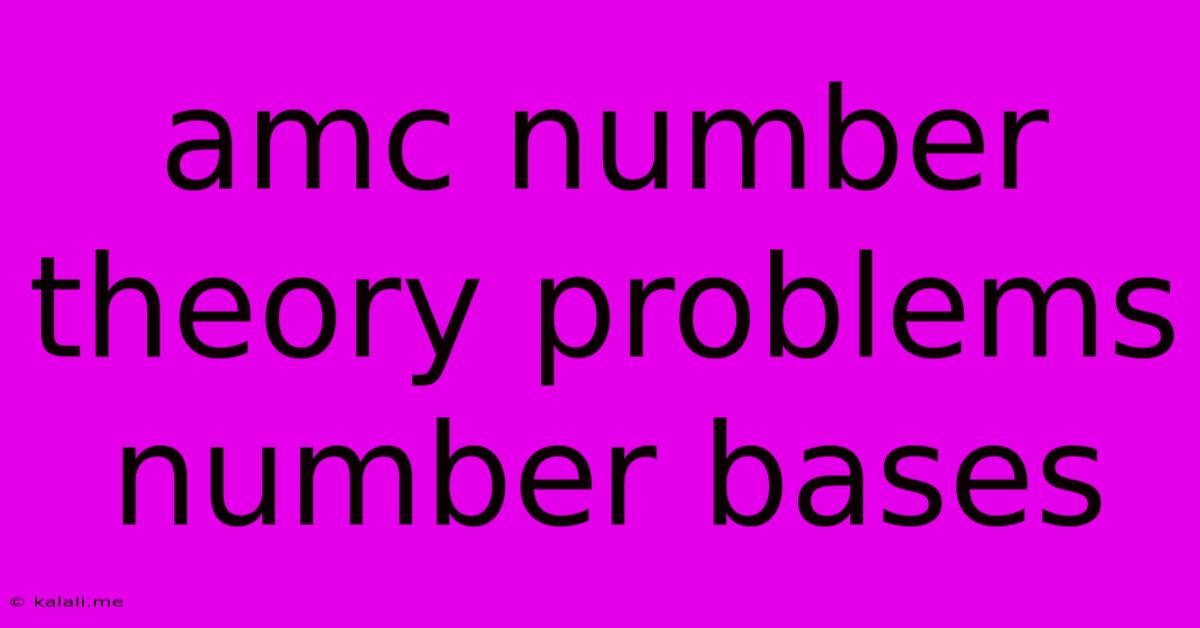Amc Number Theory Problems Number Bases
Kalali
Jun 07, 2025 · 3 min read

Table of Contents
Exploring Number Theory Problems Through the Lens of Number Bases
Number theory, the study of integers and their properties, often presents fascinating challenges. One powerful tool for tackling these problems is the concept of number bases, also known as radix. Understanding how numbers are represented in different bases can unlock elegant solutions and offer fresh perspectives on seemingly intractable problems. This article delves into several number theory problems that are significantly simplified or illuminated by employing different number bases.
What are Number Bases?
We're accustomed to the decimal (base-10) system, where numbers are represented using the digits 0-9. However, numbers can be expressed in any integer base b > 1. In base b, the digits range from 0 to b - 1. For example:
- Base 2 (Binary): Uses digits 0 and 1. Crucial in computer science.
- Base 8 (Octal): Uses digits 0-7.
- Base 16 (Hexadecimal): Uses digits 0-9 and A-F (A=10, B=11, C=12, D=13, E=14, F=15). Common in computer programming and data representation.
Converting between bases is a fundamental skill in this context. Algorithms for converting from base 10 to another base and vice versa are readily available and relatively straightforward to implement.
Number Theory Problems Enhanced by Number Bases
Let's explore how different number bases can aid in solving number theory problems:
1. Divisibility Rules:
Certain divisibility rules become more intuitive in different bases. For instance, determining divisibility by 3 or 9 in base 10 involves summing the digits. This rule stems directly from the fact that powers of 10 leave remainders of 1 when divided by 3 or 9. In base 3, divisibility by 3 is trivial – a number is divisible by 3 if its last digit is 0. Similarly, divisibility rules for other numbers can be simplified by choosing an appropriate base.
2. Finding the Remainder after Division:
Consider finding the remainder when a large number is divided by a smaller number. Converting the large number to a base that is a multiple or factor of the divisor can significantly simplify the calculation. For example, finding the remainder when a number is divided by 9 is easier in base 9, as the remainder is simply the last digit. This approach streamlines calculations, especially for very large numbers.
3. Solving Diophantine Equations:
Diophantine equations, equations where only integer solutions are sought, can sometimes be elegantly solved using different number bases. By representing the equation in a different base, the structure of the equation might become clearer, revealing patterns and simplifying the search for integer solutions. This is particularly useful for equations involving powers.
4. Identifying Palindromes and Repunits:
A palindrome is a number that reads the same forwards and backward. Repunits are numbers consisting of repeated ones (e.g., 11, 111, 1111). Analyzing palindromes and repunits in various bases can lead to interesting insights into their properties and distribution. The choice of base can highlight patterns or symmetries that are not readily apparent in base 10.
5. Exploring Number Properties in Different Bases:
The properties of numbers, such as being prime, perfect, or abundant, can manifest differently in different bases. Examining these properties across multiple bases can provide a deeper understanding of the underlying mathematical structures.
Conclusion
Number bases offer a versatile and powerful tool for exploring and solving problems in number theory. By shifting our perspective from the familiar base 10, we can uncover hidden patterns, simplify complex calculations, and gain a more profound appreciation for the richness and beauty of number theory. The ability to easily convert between bases and understand their implications is a valuable asset for any aspiring mathematician or computer scientist tackling number-theoretic challenges. Further exploration into these techniques will reveal the significant advantages offered by this seemingly simple yet remarkably effective approach.
Latest Posts
Latest Posts
-
How To Find The Exact Value Of A Trig Function
Jun 08, 2025
-
Popcorn Why Does It Get Burnt
Jun 08, 2025
-
What If Earth Had Two Moons
Jun 08, 2025
-
Games To Play Before Metal Gear Rising
Jun 08, 2025
-
District Court Asks Supreme Court Not To Rule On
Jun 08, 2025
Related Post
Thank you for visiting our website which covers about Amc Number Theory Problems Number Bases . We hope the information provided has been useful to you. Feel free to contact us if you have any questions or need further assistance. See you next time and don't miss to bookmark.